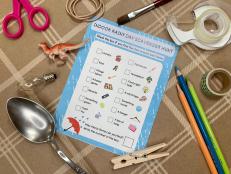Kids Media Room

Brian Patrick Flynn
Media rooms and home theaters are common features of homes these days, and more and more parents are adding a custom designed kids' media room to their home. Whether your kids and their friends are budding movie buffs, TV fanatics, super-skilled gamers or all of the above, a kids' media room can be a great addition to your home.
Prior to deciding on the kids' media room design that's right for your contingent of mini-media moguls, you'll need to decide on a location for the space. The most important features of any media room are light and sound—so you'll want to place your kids' media room in the space where you'll have as much control as possible over these factors. And in terms of sound, particularly for kids' media rooms, you'll want to ensure that sound can't get in and disturb the viewing experience, but especially that it can't get out at high volume—because there's bound to be a lot of it in a kid-themed space. Popular locations for kids' media rooms are basements and spare guest bedrooms—places that are self-contained, quiet, and won't interfere with the home's day-to-day operation when in use.
Once you've decided on a location for your kids' media room, it's time to start thinking about its technical, audio-visual (AV) and design specifications. Firstly, depending on the complexity of the media room you're planning, you may want to investigate the location's suitability for custom wiring. If your setup is going to be fairly complex, you'll probably want custom wiring for lighting, video, audio and internet access (which is recommended if there are plans for streaming video and multiplayer gaming). Additionally, to avoid an inconvenient, unsightly and unsafe tangle of wires, you'll want to ensure that you can hide the wiring for lighting and electronics in the room's drywall, or in discreet tubing throughout the room.
Once the wiring's done, it's time to consider the AV and electronic equipment you'll feature in your kids' media room. Kids' media rooms tend to be smaller affairs, so choosing the right size TV or projection screen is a must—you don't want to overwhelm the kdis with a screen that's too big for the space, or feature one that's so small they have to hunch too close to it. The room's dimensions will go a long way towards determining the size of the TV or projection screen needed, the number or speakers required for any sound system, and the scope of the lighting system if you're planning to feature one.
Once you've settled on the AV and electronics setup for your kids' media room, it's time to think about the interior design and furniture. Kids' media rooms are often unique in that they can feature fun, kid-themed accessories and furniture—from favorite-character-themed armchairs, pillows and throws to elaborate wall murals or poster art. The scope and layout of the room will be a major determining factor when it comes to the amount and type of furniture and accessories you'll choose—larger kids' media rooms may use a movie-house theme to create a real cinema-style design, while smaller rooms are more apt to feel like a traditional family room, with a comfortable layout of couches and chairs for kids to utilize while they relax and settle in for the show.
See Also: Planning Your Own Home Theater













































